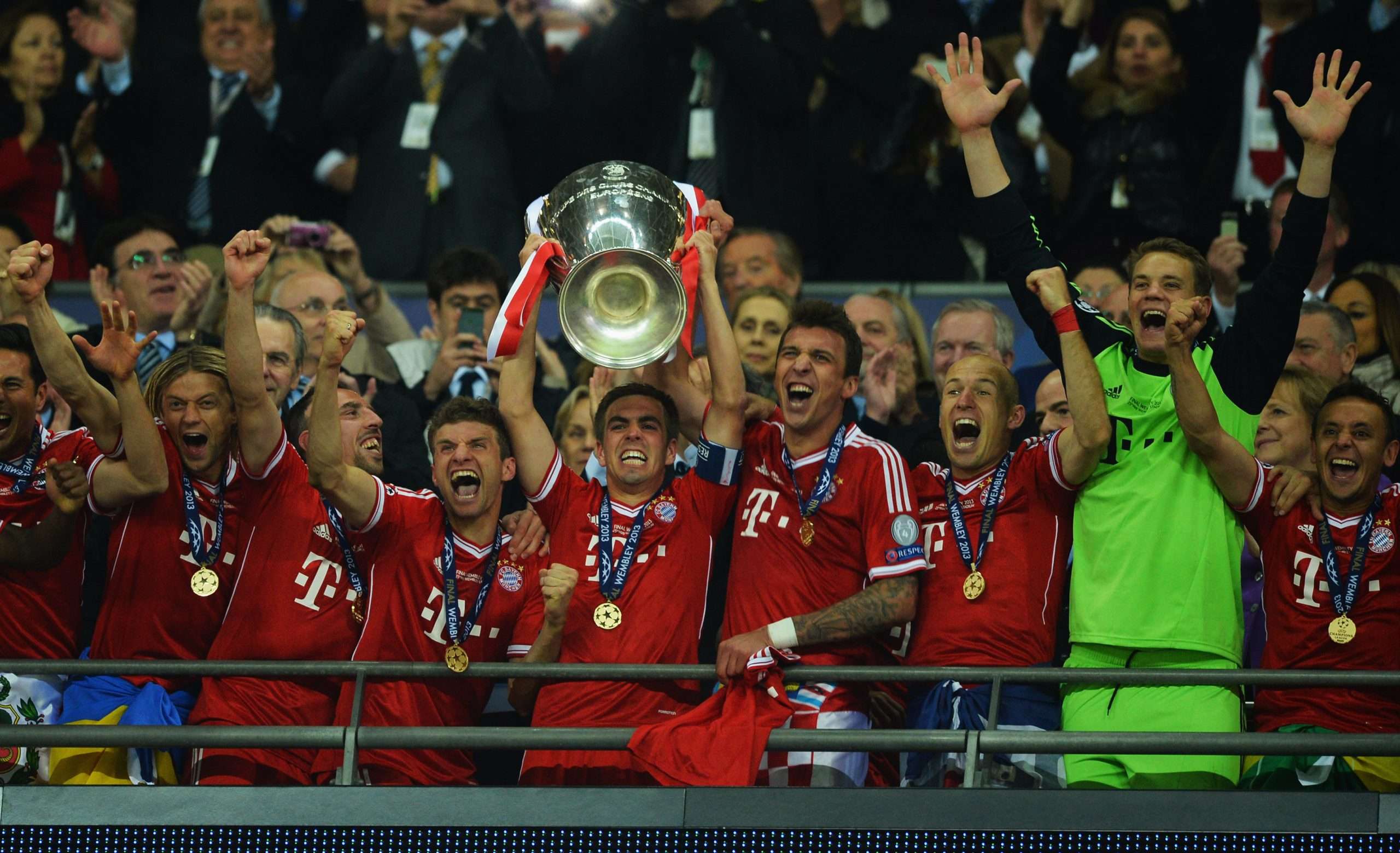The first ever all German Champions League final pit Der Klassiker on a global stage. With two of the Bundesliga’s top clubs battling it out for the crown of champion of Europe.
For Bayern Munich they were looking to complete a historic season, with a victory they would become the first German team to ever win the treble. Losing in last season’s final to Chelsea also gave it extra meaning. Jürgen Klopp and his young Borussia Dortmund would cause a huge challenge for Jupp Heynckes however. Despite winning the Bundesliga 25 points clear at the top, BVB came into the game undefeated in their last six league matches against their rivals.
In this tactical analysis we will see Jürgen Klopp’s 4-4-2 midblock, What went wrong for Dortmund in possession, and the changes Heynckes made to his tactics that would alter the game.
Lineups
Mario Götze would miss out ahead of a transfer to Bayern Munich in the summer. They would line up in a 4-4-1-1 variant. Marco Reus was moved to the attacking midfielder role behind Robert Lewandowski. Klopp’s #9 came into the game as the competition’s second highest scorer two goals behind Cristiano Ronaldo. Ilkay Gundogan made up a midfield-two with Sven Bender. Mats Hummels and Nevan Subotic were the two central defenders.
Bayern Munich came into the match in their as expected 4-2-3-1. Thomas Müller had contributed eight goals during the campaign. He played a part in an attacking four featuring Mario Manduzkic, Frank Ribery, and Arjen Robben. Javi Martinez who has made the second most interceptions in the competition was paired with the legendary Bastian Schweinsteiger in midfield.
Dortmund 4-4-2 midblock
Bayern struggled to progress the ball through Dormtund’s 4-4-2 midblock. In the first half, they only completed 36 passes in their attacking third, nine less than Dortmund despite having the majority of possession. Klopp would produce these results through a more passive press that used pressing triggers and cover shadows to create turnovers and force long passes.
Lewandowski and Reus occupy the two Bayern centre-backs. But they do not aggressively press them and instead look to manipulate their passing options and angles. The second line of pressure which was the four man midfield was relatively high up the pitch, so when the ball was passed to a fullback it would set off a pressing trigger for the wide player to attack the ball carrier.
In the sequence below, Reus recognises the opportunity to force Boateng wide. Pressuring him at an angle that created a cover shadow against the passing option Javi Martinez in midfield and forced his only options to pass to Lahm or a long-pass. Boateng in this example recognises that Lahm would be pressured immediately so opts for a long-pass creating a turnover for Dortmund.
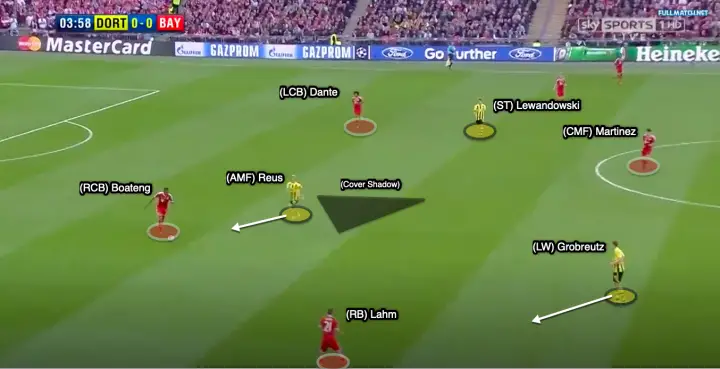
Heynckes tweaks makes solution
The German champions possess immense quality and dynamism in their squad which allowed them to create different solutions against this press from the Black and Yellow.
One particularly favoured option was to make long-passes, completely bypassing the press and six Dortmund players. These would be targeted to Mario Mandzukic who being at 6″3′ paired with his technical quality makes him a perfectly well rounded in the target-man role. He was involved in 10 aerial duels. Making knockdowns for Robben and Müller. This would not be a consistent solution however and would be scrapped in the second half and would contribute to a more consistent solution.
Bastian Schweinsteiger would drop into the defensive line to create a 3v2 against Dortmund’s first line of pressure and create new passing options. With how high Dormtund’s midfield line pressed though they still struggled to create progressive short passing sequences.
Heynckes would adjust this by tweaking the structure in possession encouraging the wide players to provide width on either side of the pitch, stretching Dortmund’s 4-4-2. Rather than the idea in the first half to have Robben come inside looking for knockdowns from Mandzukic.
This also made the defensive have more width in it as you can see below, which made it easier to rotate the ball side-to-side before Dortmund could shift and execute their pressing trigger.
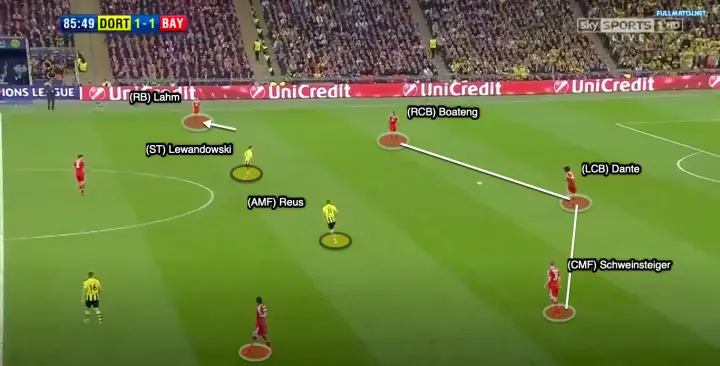
Dortmund struggle in possession
Dortmund would only create two big chances to Bayern’s seven. Bayern conceded zero goals across their four quarter-final and semi-final matches, it was always going to be a challenge to penetrate their defence but as we will see through analysis they did not help themselves.
In attacking transition and the final third they exhibited the lack of experience you would probably expect out of their young team. When winning the ball, they would fail to recognise when to quickly move the ball forward or retain possession. Forcing the ball forwards when there was no real opportunity to do so would result in many turnovers and wasted pressure regains.
At the time young, Reus, Hummels, and Gundogan were all culprits for driving the ball forwards aimlessly and ignoring open passing angles which would see them closed down and resulted in the Bavarians regaining possession. This would see Dortmund fail to get in a rhythm or starve Heynckes team of the ball for long periods, and in the second-half struggle to get out of their own half at times.
Because of this Bayern’s defenders were rarely challenged, with 0% of Dortmund’s shots coming from inside the six yard box. Below is an example where Reus receives the ball in-between the lines, turns and then realises he is stuck in a 5v2 situation. Rather than making a first-time pass to Gundogan or Bender originally which would have seen them keep the ball.
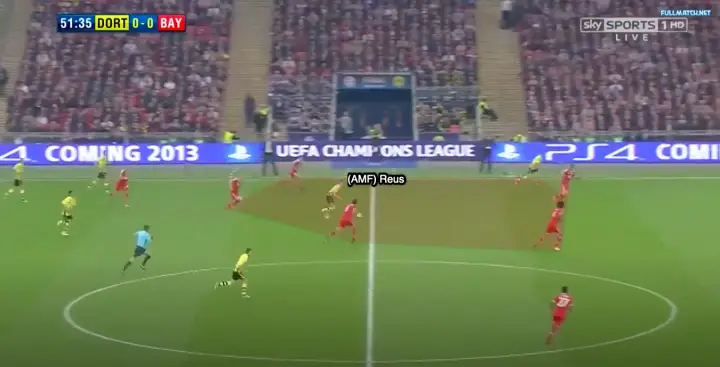
Dortmund high-line comes at a cost
Playing a high defensive line comes with pressing the opposition. It can be seen as a “high-risk, high-reward” approach for some teams and can be exposed by the opposition.
There were signs of this being the case in the first half for Dortmund and Jupp Heynckes picked up on this. They came into the game only keeping three clean sheets in their last 12 games. As Dortmund’s defenders across the back four struggle significantly in their athletic qualities, runs in-behind can cause problems. So Bayern in the second half would begin to launch long-passes in-behind and assaulting the attacking third with players making runs into the interior channels from the likes of Robben, Muller and Mandzukic.
This collimated with stretching the defensive shape, would create deadly and game-changing results and for Klopp’s boys. Robben would create Bayern’s first goal from an interior run in which the space was provided from Dortmund’s defensive line being stretched. The second and winning goal was provided from a long-pass in-behind Dortmund’s defensive line.
Below is another specific example where a long-pass provides a potential for a 2v1 against Mats Hummels but Subotic is able to make a goal-saving recovery tackle in the end.
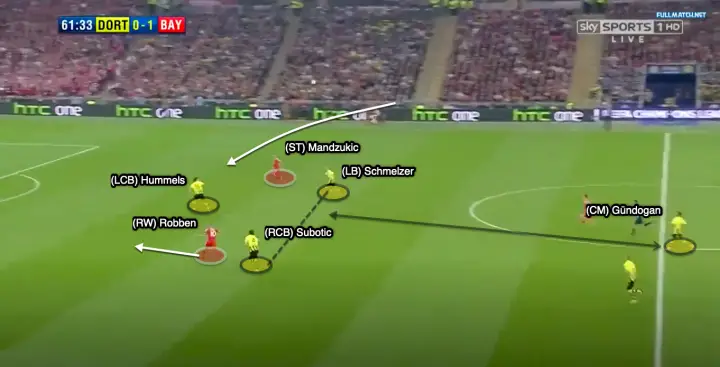
Conclusion
Dortmund’s youth and inexperience would be bested on the pitch through the Bavarian individuals and in the dugout. The execution of Dortmund’s principles in possession was poor and uncharacteristic on the night and would cause a cycle of problems that saw them be pinned in their half and fail to produce problems across the 90 minutes for the opposition. Jupp Heynckes deserves a lot of credit for identifying ways to tweak his tactics to exploit Dortmund’s shape against them and ultimately these tactics would directly correlate into two goals to lift the Champions League trophy.
By Craig Moniz.



